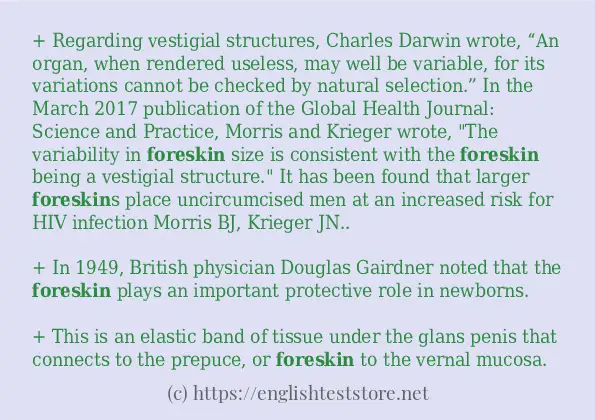How to use in-sentence of “foreskin”:
+ Regarding vestigial structures, Charles Darwin wrote, “An organ, when rendered useless, may well be variable, for its variations cannot be checked by natural selection.” In the March 2017 publication of the Global Health Journal: Science and Practice, Morris and Krieger wrote, “The variability in foreskin size is consistent with the foreskin being a vestigial structure.” It has been found that larger foreskins place uncircumcised men at an increased risk for HIV infection Morris BJ, Krieger JN..
+ In 1949, British physician Douglas Gairdner noted that the foreskin plays an important protective role in newborns.
+ This is an elastic band of tissue under the glans penis that connects to the prepuce, or foreskin to the vernal mucosa.
+ Some males have the foreskin cut off when they are adults because they have problems with their foreskin.
+ The area on the bottom of the penis, where the foreskin is attached on uncircumcised men, is known as the frenulum.
+ One study, conducted in 2015, determined that the foreskin does not provide a sexual response or serve a sexual function in men.

Example sentences of “foreskin”:
+ The area of the outer and inner foreskin combined spans a wide range: 7–100 cm2 and 18–68 cm2 respectively.
+ The outside of the foreskin is like normal skin but the inside of the foreskin is a membrane like the inside of an eyelid or mouth.
+ The foreskin is the least sensitive hairless tissue of the body.
+ The end of the corpus spongiosum forms the glans penis which is underneath the foreskin in uncircumcised males.
+ The foreskin contains Meissner’s corpuscles, which are nerve endings involved in fine-touch sensitivity.
+ The foreskin can keep the glans penis comfortable, moist, and protect it.
+ Tying the foreskin is sometimes a subject in vase painting.
+ It is found around the foreskin of the penis in males, or in the folds of skin around the vulva in females.
+ Athletes sometimes used a cord called a “dog leash” to tie off the foreskin of the penis.
+ Circumcision is an operation in which the foreskin is removed.
+ They are most numerous in the “ridged band”, the junction of the inner and outer foreskin layers, and least numerous in the smooth inner layer of foreskin.
+ The penis has started to swell up, the veins are starting to show, and the foreskin has begun to slip back.
+ Some males have the foreskin cut off because they want to change how their penis looks.
+ Most male mammals either have a foreskin that covers the glans penis or a sheath in which the whole penis can retract.
+ The foreskin is about the same color as the skin on the side of the penis.
+ The foreskin is attached to the penis by the frenulum, but it can move.
+ Restoring the foreskin would involve expanding the skin to make something similar to the foreskin, but connective tissues cut during circumcision cannot be brought back.
+ The foreskin can be pierced or slit for fashion reasons.
+ It was deduced that even a retracted foreskin would tend to reduce the stimulus to the corona and frenular areas, particularly on the outward stroke of intercourse.
+ The area of the outer and inner foreskin combined spans a wide range: 7–100 cm2 and 18–68 cm2 respectively.
+ The outside of the foreskin is like normal skin but the inside of the foreskin is a membrane like the inside of an eyelid or mouth.
+ The foreskin is the least sensitive hairless tissue of the body.

